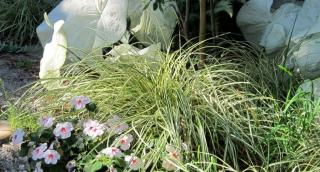

Short but dense, Oshima sedge or Carex hachijoensis ‘Evergold’ hits the spot in the garden with striped leaves that visually lighten up its surroundings.
C. hachijoensis ‘Evergold’ facts
Botanical name – Carex hachijoensis ‘Evergold’ or Carex oshimensis ‘Evergold’
Common name – Oshima sedge
Family – Cyperaceae
Type – Grass
Bearing – Upright mound
Height – 6 to 8 inches (15 to 20 cm)
Planting density – 8 to 10 plants per sq. yard (m²)
Exposure – sun or part sun
Soil – any type, as long as well drained
Flowering – in spring, but it’s rare
Carex hachijoensis comes to us from Japan. Green leaves marked with a bright yellow stripe down the center make this grassy plant an uncommon and striking option to add brightness to your flower beds.
Oshima sedge loves all types of soil, the only condition is that it must drain very well and contain lots of humus.
Before planting your Carex, take great care to add a layer of draining material at the bottom of the hole you dug out, especially if soil in the area tends to retain water too much. There are many ways to accomplish this: pozzolana, clay pebbles, gravel etc.
Also, enrich the soil with either compost, nutritious soil mix, or animal manure.
 Once planted, Carex hachijoensis doesn’t require anything specific in terms of care. Unlike a number of other grasses that require cutting back at the beginning of Spring, Carex hachijoensis will keep its beautiful foliage all year long.
Once planted, Carex hachijoensis doesn’t require anything specific in terms of care. Unlike a number of other grasses that require cutting back at the beginning of Spring, Carex hachijoensis will keep its beautiful foliage all year long.
Quite the hardy one – it can take on temperatures in the single digits Fahrenheit (-15° Celsius) – you won’t need to protect it in Winter.
Carex hachijoensis can be propagated through sowing. However, since the blooming is very rare, it’s easier to pursue the clump division technique to split each clump into several more Carex. It’s an easy method to master.
C. hachijoensis isn’t vulnerable to diseases. However, you’ll likely encounter aphids. They typically gather at the base of each stem and, in the long run, weaken the plant.
Carex hachijoensis is one of the most versatile grasses: cover the ground in a flower bed, wind it along walkway edges, or pair it with bloomers in a garden box. As for Carex hachijoensis ‘Evergold’ in pots or garden boxes, ensure that the soil always remains a bit damp but never wet.
The bright color of its leafage will visually pair very well with darker-leaved plants, such as Ophiopogon planiscapsus ‘Nigrescens’, Heuchera micranta ‘Palace purple’, crimson-colored Imperata cylindrica ‘Red baron’, steel-blue Festuca glauca, etc. Not only will this generate interesting patterns in your garden, but plants will be bolstering each other’s beauty completely naturally!
Of course, this is a plant that looks strikingly similar to Chlorophytum and to a special Dracaena marginata variety, the ‘Ray of Sunshine’ (the ‘Kiwi’ is also similar). Set one or the other at a distance to make onlookers wonder, “Is it grass? Is it a shrub?”… leaving them joyfully bewildered!
There’s no need to “shave” this grassy plant, unlike most other ones. It’ll stay beautiful throughout winter, too!